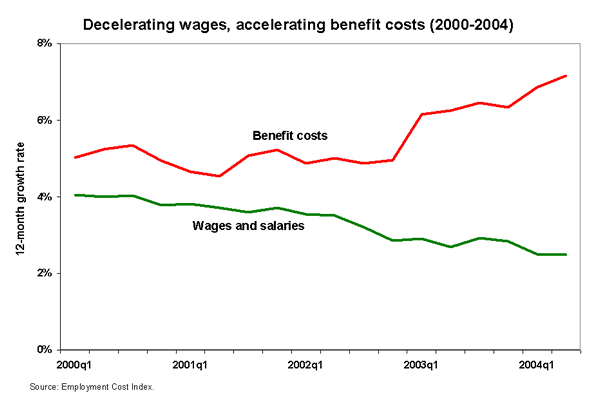See Snapshots Archive.
Snapshot for August 4, 2004
Wages and salaries at unprecedented low growth rate
Since 2000, average compensation growth as measured by the Employment Cost Index (ECI) has hovered around 4%, a solid growth rate that has easily outpaced inflation. But this overall trend in compensation masks very different underlying movements in the two components of compensation: wages and benefits. These two elements of compensation have sharply diverged over the past four years. Unfortunately, the standard of living of workers is more closely tied to trend in wage growth, which has been declining.
As shown in the figure below, for the past two quarters, the 12-month growth rate of the wage and salary component of the ECI was 2.5%, the slowest ever recorded for this series (ECI data go back to the early 1980s), and even slightly behind inflation for the last 12 months (2.8%). This component of the ECI has not fallen short of inflation since 1995. The trend in wages and salaries tracks labor market conditions fairly closely, slowing consistently throughout the recession and jobless recovery. Other wage series show a similar recent deceleration in the face of persistent slack in the job market (See the July 16 Snapshot for further analysis).

Benefit growth, however, has trended sharply in the other direction. Driven largely by rapidly increasing health care costs, the benefit component of earnings was rising at about 5% per year through 2002, and recently escalated further. In the last year, benefit costs have grown 4.7% faster than wages, the highest differential on record.
These divergent trends have important implications regarding the extent to which the benefits of the expanding economy are reaching working families. First, most workers depend on the wage component of their paycheck to meet their consumption needs. To the extent that employers are paying higher health care premiums because of health inflation and not improved health benefits, the rise in benefit costs does not indicate that workers’ standard of living is improving. True, those who are covered by employer-provided health insurance will benefit from their employer’s higher expenditures on their health care, but this won’t help them pay for expenses such as gas, housing, education, and even out-of-pocket medical care.
Second, most workers in the lower half of the wage scale do not receive health benefits from their employers. The most recent data show that in 2002, 38% of those in the bottom 40% of the wage scale got health care coverage through the jobs. Among those in the top fifth of the wage scale, 79% received health insurance through their employers. Thus, many workers are losing ground right now because they depend exclusively on wages to meet their needs.
Finally, the increasing cost of benefits dampens employers’ willingness to hire, prolonging the slack labor market conditions that have led to the slowing of wage growth.
Today’s Snapshot was written by EPI economist Elise Gould and EPI senior economist Jared Bernstein.
